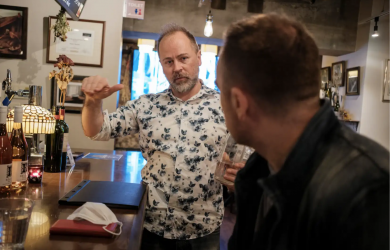
September 7, 2011
Blue Mind
It’s about finding your inner Blue Man, says Tokyo show’s Callum Grant
Originally published on metropolis.co.jp on September 2011

Blue Man fast facts
Why blue? “Legend has it that cofounder Chris Wink literally dreamed of the Blue Man since childhood. Also, if we were green everyone would call us Alien Man Group, or red would be Devil Man Group.” How many Blue Men are there worldwide? “There are approximately 60 Blue Men across the globe, but that number changes all the time. Some Blue Men just melt, others dry out and some end up getting turned into crayons.” How much paint do you go through each show? “We actually don’t use that much paint. In terms of the paint for drumming it’s watered down so a little goes a long way, and for us it’s only one tub of blue each per show.” How were the pipe instruments born? “While unpacking some boxes one day, cofounder Phil Stanton dropped a cardboard tube. When it hit the ground it made an interesting sound. They experimented combining different lengths and the Drumbone was born.” Are there Blue Women? “Indeed there have been, and we hope for more. The race must continue!”
Roppongi Blue Man Theater. http://blueman.jp
Part of the magic that’s made avant-garde New York performance art show Blue Man Group a worldwide long-runner is the mystery behind it. We don’t know the names of the performers, how they came to be doing the odd things they do—or even why they wear blue paint, anyway.
Ignorance turned out to be the key to getting a part in the show for Scot Callum Grant. “I was very lucky—I was studying contemporary theater and had never seen Blue Man,” he explains backstage at the group’s Roppongi theater. “A friend said, ‘I think you’d be a good Blue Man.’ I had no idea what he was talking about. He said, ‘Look, they’re auditioning in two weeks in Glasgow, and I think you should go.’ It was the only time they’d ever auditioned in Scotland. I couldn’t find the place and almost gave up. But then they invited me to London.
“It’s funny. I’ve since sat in on other auditions, and I think not knowing what it was helped me. People who know end up doing their impression of Blue Man—a kind of robot Frankenstein—which is completely not the character. Not knowing helped me have an open mind.”
Grant joined Blue Man at 22 after a two-month process that winnowed down an initial hundred candidates to the final three new Blue Men. After stints in Amsterdam, Berlin, London, Oberhausen, Zurich and New York, he came to Tokyo to open the show in 2007.
Learning to be a Blue Man meant developing his musical skills to be able to play their trademark tube “Drumbone” instruments, mastering the art of nonverbal communication—and a lot of practice catching marshmallows in his mouth.
Along with cultivating an unusual skill set, Grant says Blue Man has to tweak each city’s show for the specific culture of its spectators. In Tokyo this meant everything from replacing stunts involving Twinkies with Tokyo Banana (“much tastier!”), to including references to Japanese social realities that make the gags resonate with domestic audiences. “There’s a big part of the show about internet cafés,” he notes. “It was addressing the fact that people used internet cafés to check their email, but didn’t interact. This was magnified when we came here and found out about internet cafés that people essentially live in all the time. We adjusted the piece for the internet café culture here. The jokes ended up pretty close to the truth.”
Another adjustment to Japan was getting used to its famously reserved audiences. Audience participation is a big part of Blue Man, and when this writer went to the show a forty-something salaryman who was swooped out of the audience, trussed up backstage and swung upside down against a canvas looked a bit out of sorts. Still, Grant says that despite what you may think, Japanese audiences are game for just about anything.
“In terms of audience participation, people are surprised when we say that Japanese people are really into it,” he explains. “People expect the Japanese to be reserved, but as soon as the audience works out that this environment is okay to do what ever you want, they’re amazingly positive. In other cities, sometimes the guests don’t want to be there, but in Japan people are always psyched.”
Ultimately, Grant says it’s the things that people have in common that make the show work anywhere. “There’s a Blue Man in everyone. That’s the idea behind the show,” he says. “To get the connection with everyone and get them to realize there is a Blue Man in all of us.”
Grant has spent his entire life as an adult clown, and seems to enjoy every minute of it. For him the joy comes from inhabiting a character that is a weird mixture between a “superhero, clown, scientist and a three-year-old child. It knows nothing, but sees the potential in everything.”
How do people react when he tells them he’s a Blue Man? “They usually say: ‘Really?’ And sometimes there is a moment of disbelief. It’s humbling. People are excited and it makes me proud. It’s like the secret identity has been revealed briefly, and it’s fun.”
With Cirque de Soleil’s Zed show at Tokyo Disneyland closing down after the quake, the viability of blockbusters like Blue Man is being called into question. Blue Man Tokyo has its contract extended on a three-month basis by backers ad giant Hakuhodo and promoter Amuse.
But since the disaster, the show has become part of the recovery. “The performance with Kodo was the first thing we did after the quake,” Grant says about a show Blue Man taped soon after 3/11 with the renowned taiko drum troupe for broadcast on Wowow. “I remember that being one of the first live events post-disaster. We had 8-900 people in the house and the response was so powerful—it was a reaffirmation to get back to doing shows. And it’s been similar since. People are ready to enjoy themselves.”
“The show is about connection,” he concludes. “And never has there been a time when that’s more needed.”





